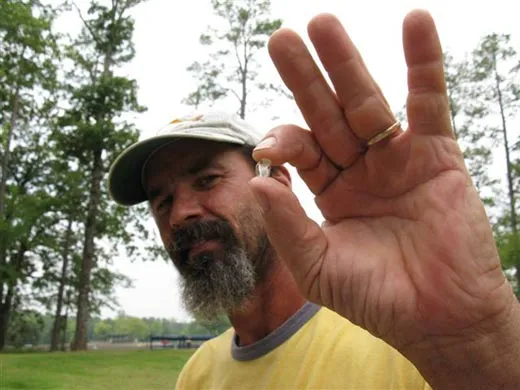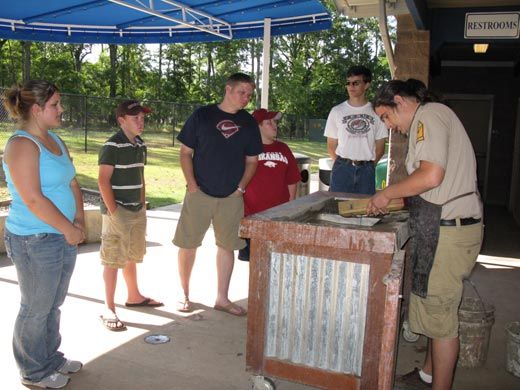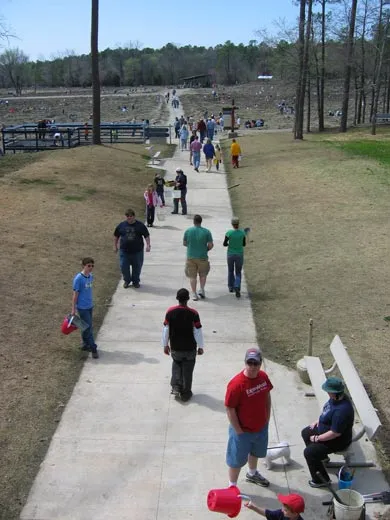The Curious Case of the Arkansas Diamonds
In a state park full of amateur diamond miners, one prospector dug up a valuable stone worth thousands of dollars—or did he?
/https://tf-cmsv2-smithsonianmag-media.s3.amazonaws.com/filer/2-ct-Crater-of-Diamonds-State-Park-631.jpg)
At Crater of Diamonds State Park in Arkansas, visitors can pay a $7 admission fee, grab a shovel and try their hand at diamond prospecting. The rule is "finders keepers." Over the past three years, annual visitation has tripled to 170,000, and in 2007 tourists pulled more than 1,000 precious stones from the ground. Some visitors use a special screen known as a seruca to wash and separate the heavier diamonds from the lighter debris. Others just get down on their hands and knees, squinting for jewels in the furrows. The 800-acre park holds out the hope, however slim, that just about anyone can strike it rich. Unfortunately, the park may also hold out a temptation for mineralogical mischief.
Eric Blake, a 33-year-old carpenter, has been coming to Crater of Diamonds two or three times a year ever since his grandfather first took him there when he was a teenager. In October 2007, his hard work finally paid off with the discovery of a whopping 3.9-carat stone—nearly the size of the site's Kahn Canary diamond that Hillary Clinton borrowed for her Arkansas-born husband's presidential inaugural galas. It's the kind of rare find that's spectacular enough to attract national attention. Blake reportedly spotted the elongate, white diamond along a trail just as he was plunking down a 70-pound bucket of mud and gravel he planned to sort through.
His lucky stone could be worth as much as $8,000—if he can prove it came from Arkansas soil. In the year since his discovery, fellow collectors, park officials and law enforcement officers have started wondering how Blake and his family uncovered an unprecedented 32 diamonds in less than a week.
"We have a concern of maintaining the integrity of not only the park, but the state of Arkansas," says park superintendent Tom Stolarz, who caught a glimpse of the diamond as Blake was packing to leave the park. Although Stolarz is not a geologist, he has been at the park for 26 years and has handled more than 10,000 diamonds, paying special attention to large stones. Blake's rough-hewn gem was certainly a diamond to Stolarz's eyes, but was it an American diamond?
The answer is more important than one might think. Diamonds are merely crystallized carbon and today they can be created economically in a lab. But the stones fascinate people; the National Museum of Natural History's diamond exhibit, featuring the Hope Diamond, is one of the most popular destinations in the Smithsonian Institution. For many diamond buyers, history buffs and a quirky subculture of dedicated diamond hunters, provenance is everything.
Diamonds were discovered in Arkansas in August 1906, when a farmer named John Wesley Huddleston found a "glittering pebble" on his property. The next year the New York Times described "Diamond John's" treasure in epic terms: "The story of the discovery of diamond fields in one of the poorest counties of the not over-rich State of Arkansas reads like a chapter of Sinbad's adventures."
More than 10,000 dreamers flocked to nearby Murfreesboro, filling up the ramshackle Conway Hotel and striking up a tent city between town and the diamond field. It was not an easy life, says Mike Howard of the Arkansas Geological Survey. "Many people came, few people found," he says. "Most were gone within a couple of years." The majority of Arkansas diamonds, then as now, come in at under ten points, or about 1/10th of a carat. But in 1924, one lucky miner pulled a 40-carat monster out of the ground. Christened Uncle Sam, it remains the largest diamond ever discovered in the United States and a twinkle in every miner's eye.
A lot of funny business has gone on around the diamond field over the past century. After failing to gain full control of the area in 1910, the London-based Diamond Syndicate allegedly set up a sham operation to downplay the mine's potential and sabotage production, according to a Justice Department investigation. In 1919, two rival processing plants burned to the ground on the same January night, fueling rumors that someone was out to destroy the mine's profitability. In the late 1920s, Henry Ford was set to buy Arkansas industrial diamonds for his assembly lines, but the Diamond Syndicate and De Beers bribed the mine's owner to keep it out of commission. Shenanigans continued into the 1950s, when, for instance, an entrepreneur trucked some gravel from the diamond field to his own five acres north of town and plunked down a sign claiming he had a diamond mine. Locals found him beaten up in a ditch the next morning, according to a story one Arkansas geologist has told over the years.
The state of Arkansas purchased Huddleston's former property in 1972 and established Crater of Diamonds State Park, but that wasn't enough to ensure the site's integrity. According to the book Glitter & Greed by Janine Roberts, mining companies tried, and failed, to get legislation passed to open the park up for commercial exploration. By the mid-1980s, several companies were running aerial magnetic surveys to hunt for undiscovered pipes of diamond-rich rock outside the park's boundaries. "It was something else," says Howard, who recalls seeing their helicopters in motel parking lots. They identified one new pipe, but it was far too small to be worth exploiting.
In 1987, then-governor Bill Clinton put together a controversial task force to explore the Crater's commercial mining prospects. One diamond executive estimated it could hold diamonds worth $5 billion. The Sierra Club, the Arkansas Wildlife Federation and Friends of Crater of Diamonds State Park fought unsuccessfully in federal court to halt the plans. By 1992, exploratory drilling was approved—with environmental caveats—and geologist Howard was assigned to keep abreast of the work being conducted by four mining companies. If the drilling had been successful, tourists would have been barred from the main pipe itself, although rock and debris would have been set aside for them to root through, and they could have toured the processing plant. Some locals were miffed; others looked forward to the estimated 800 jobs mining could bring to the economically depressed region.
But after they processed 8,000 tons of rock, diamonds proved too rare to make the scheme profitable. The miners packed up their processing plant and shipped it to Canada. Their drilling cores, however, provided geologists with the first extensive maps of the diamond-bearing cone of lamproite rock. "Being a scientist, I wanted to have that information," says Howard. The surface area of the diamond field is 83 acres, and the cone funnels to a point some 700 feet below, making it the tenth-largest cone known in the world. Howard says it's shaped like a martini glass.
Arkansas diamonds originally formed more than three billion years ago under intense heat and pressure some 60 to 100 miles below the earth's surface. Then, about 100 million years ago, a giant gas bubble formed in the earth's roiling magma and shot up to the surface at 60 to 80 miles per hour, pulling diamonds and other material with it before launching into the air and raining debris back down. Some 60 to 80 percent of the diamonds forced to the surface were probably destroyed during this violent process. The park contains the largest cone, but five others—covering just a few acres each—are also in the area.
Though the diamonds could not support a commercial operation, there is still room for profit. Arkansas diamonds fetch about ten times more per carat than comparable stones, largely because collectors value the diamonds' American provenance and unique character. Many of the stones are smooth and rounded like a drop of glass, and they are among the hardest in the world. They come in three colors: white, yellow and brown. There's practically no other major mine in the world with stones that could pass for Arkansas natives, except maybe the Panna mines in India. (The similarity among the two sites' stones is likely to be skin-deep, says Howard, although no one has documented the trace elements that could be used to fingerprint Arkansas diamonds.) If Blake's 3.9-carat stone were an import, it wouldn't net more than several hundred dollars. The rest of his stones would fetch far less.
When park superintendent Stolarz saw Blake's diamond, he suggested Blake show it to Howard at the Arkansas Geological Survey. Howard was on vacation but made a special trip to his Little Rock office when he got the call about the big diamond. But Blake, who was driving back to Wisconsin with his fiancée and her daughter and sister, never showed up. Howard called Blake's cell phone again and again to no avail. He reached Blake a few days later, and Blake explained that he "had a flat tire and didn't have time to come by," Howard recalls.
A few weeks later, photographs of Blake's stones popped up on eBay and Blake's own Web site, Arkansas Diamond Jewelry.
When word of Blake's finds reached the Murfreesboro Miner's Camp, a trailer park and campground that hosts a population of good-natured diamond hunters, people were a tinge jealous. And suspicious. "I was like 'Jeez!'" says Denis Tyrell, 49-year-old licensed handyman who says he has made a living digging diamonds for the last 18 months. "You don't just come here, pick a spot, find 40 diamonds, and say 'I'll see you next year!'" It took Tyrell ten days to find his first diamond when he arrived at the park in June 2006. His personal best rate has been 38 diamonds in 31 days, a record he achieved in October 2008.
For all their suspicions, there was no evidence of wrongdoing. Then a fossil and mineral dealer named Yinan Wang noticed something strange. In September 2007, he had purchased one of Blake's smaller diamonds for $200. That December, Wang was interested in doing business with an Indian dealer named Malay Hirani. Wang asked Hirani to share a copy of a recent Kimberley Process Certificate, which would ensure that his rough diamonds were not the so-called blood diamonds traded by warlords in Africa and would verify that Hirani had previously done business in the United States. By chance, the certificate Hirani copied for Wang had come from an order Hirani had sent to Blake. Wang—simply sizing up his potential business partner—decided to ask Blake if Hirani was trustworthy. To his surprise, Blake denied the connection: All our diamonds are from the U.S., he said, according to Wang.
Wang didn't think much about the incident until March 2008. He was chatting with Hirani about sources for rough diamonds, and Wang mentioned Blake's Web site. The dealer looked at it and immediately thought he recognized some of Blake's jewels as his own. "I realized I had stumbled on something relatively big," Wang says. Hirani shared his receipts, shipping confirmation numbers, and photographs with Wang, and the duo later tracked the 3.9-carat diamond to another source, they say: a Belgian dealer named Philippe Klapholz. Tipped off by Wang, who was operating under the alias "Hal Guyot," the Web site Fakeminerals.com spelled out the alleged fraud.
If Blake really did plant foreign diamonds in Arkansas soil, was it a crime? Pike County Sheriff Preston Glenn is investigating Blake and expects to complete his work in early 2009, but says it would be up to the prosecuting attorney to determine what charges, if any, to pursue. In the meantime, officials say that Blake has agreed not to return to Crater of Diamonds State Park.
Blake says he has done nothing wrong and simply posted the wrong photos on his site. "A couple of diamonds were in question, but nobody has proven anything," he says.
One Friday afternoon this past August, the diamond hunter Tyrell finally had his own lucky strike—he pulled a 4.42-carat stone out of the ground. For a while, it seemed, Blake's alleged chicanery was no longer the talk of Murfreesboro. It was Tyrell's big day, and no one around there doubts that Tyrell's stone is legitimate. Stolarz sees him out in the park nearly every day, sorting through pebbles and taking samples home to examine come nightfall.
Author Bio: Brendan Borrell wrote about Cassowaries, the world's most dangerous bird, in the October 2008 issue of Smithsonian magazine


